The shutil module helps you to accomplish tasks, such as: copying, moving, or removing directory trees.
This python script creates a zip file in the current directory containing all contents of dir and then clears dir.
import shutil
from os import makedirs
def zip(out_fileName, dir):
shutil.make_archive(str(out_fileName), 'zip', dir)
shutil.rmtree(dir)
makedirs(dir[:-1])
Is a blog about python programming language. You can see my work with python programming language, tutorials and news.
Sunday, October 21, 2018
The shutil python module.
Posted by
Cătălin George Feștilă
Labels:
2.7,
2017,
python,
python modules,
shutil,
tutorial,
tutorials
The scapy python module - part 002.
This is another python tutorial about scapy python module.
The last was made on Linux and now I used Windows 10 OS.
Let's install this python module with python version 2.7.13 and pip.
The last was made on Linux and now I used Windows 10 OS.
Let's install this python module with python version 2.7.13 and pip.
C:\>cd Python27
C:\Python27>cd Scripts
C:\Python27\Scripts>pip install scapy
Collecting scapy
Downloading scapy-2.3.3.tgz (1.4MB)
100% |################################| 1.4MB 736kB/s
In the tar file c:\users\mythcat\appdata\local\temp\pip-26vi9x-unpack\scapy-2.3.3.tgz
the member scapy-2.3.3/README is invalid: unable to resolve link inside archive
Installing collected packages: scapy
Running setup.py install for scapy ... done
Successfully installed scapy-2.3.3C:\Python27\Scripts>python
Python 2.7.13 (v2.7.13:a06454b1afa1, Dec 17 2016, 20:42:59) [MSC v.1500 32 bit (Intel)] on win32
Type "help", "copyright", "credits" or "license" for more information.
>>> import scapy
>>> from scapy import *
>>> dir(scapy)
['VERSION', '_SCAPY_PKG_DIR', '__builtins__', '__doc__', '__file__', '__name__', '__package__',
'__path__', '_version', '_version_from_git_describe', 'base_classes', 'config', 'dadict', 'data',
'error', 'os', 'plist', 'pton_ntop', 're', 'subprocess', 'supersocket', 'themes', 'utils',
'with_statement']
Posted by
Cătălin George Feștilă
Labels:
2.7,
2017,
python,
python modules,
scapy,
tutorial,
tutorials
Using PyUSB with python 3.x .
C:\Python34\Scripts>pip3.4.exe install PyUSB
Downloading/unpacking PyUSB
Running setup.py (path:C:\Users\mythcat\AppData\Local\Temp\pip_build_mythcat\PyUSB\setup.py)
egg_info for package PyUSB
Installing collected packages: PyUSB
Running setup.py install for PyUSB
Successfully installed PyUSB
Cleaning up...
If not, you can get errors like this: raise NoBackendError('No backend available')
usb.core.NoBackendError: No backend available
Let's make a simple test example:
import usb.core
import usb.util
import sys
class find_class(object):
def __init__(self, class_):
self._class = class_
def __call__(self, device):
# first, let's check the device
if device.bDeviceClass == self._class:
return True
# ok, transverse all devices to find an
# interface that matches our class
for cfg in device:
# find_descriptor: what's it?
intf = usb.util.find_descriptor(
cfg,
bInterfaceClass=self._class
)
if intf is not None:
return True
return False
all = usb.core.find(find_all=1, custom_match=find_class(7))
print (all)C:\Python34>python.exe usb_devs.py
< generator 0x0000000003d8d5e8="" at="" device_iter="" object="" >
Posted by
Cătălin George Feștilă
Labels:
2017,
error,
python 3,
python modules,
PyUSB,
tutorial,
tutorials
The ansible python module - part 001.
Ansible is an IT automation tool.
It can configure systems, deploy software, and orchestrate more advanced IT tasks such as continuous deployments or zero downtime rolling updates.
First, you need to install the VCForPython27.
Install now the pycrypto python module:
It can configure systems, deploy software, and orchestrate more advanced IT tasks such as continuous deployments or zero downtime rolling updates.
First, you need to install the VCForPython27.
Install now the pycrypto python module:
C:\Python27\Scripts>pip install --upgrade --trusted-host pypi.python.org pycrypto
Collecting pycrypto
Downloading pycrypto-2.6.1.tar.gz (446kB)
100% |################################| 450kB 3.8MB/s
Installing collected packages: pycrypto
Running setup.py install for pycrypto ... done
Successfully installed pycrypto-2.6.1C:\Python27\Scripts>pip install --trusted-host pypi.python.org ansible
Collecting ansible
Downloading ansible-2.3.0.0.tar.gz (4.3MB)
100% |################################| 4.3MB 365kB/s
Requirement already satisfied: jinja2 in c:\python27\lib\site-packages (from ansible)
Collecting PyYAML (from ansible)
...
Installing collected packages: ansible
Running setup.py install for ansible ... done
Successfully installed ansible-2.3.0.0
Posted by
Cătălin George Feștilă
Labels:
2.7,
2017,
ansible,
pip2.7,
pycrypto,
python,
python modules,
tutorial,
tutorials
Programmer's Notepad - free editor with PyPN python module.
Programmer's Notepad is a free, open source, text editor with special features for coders.
This editor comes with a variety of text clips representing common programming languages.
I saw 43 of text clips to start your programming.
Featuring
Syntax highlighting
Text Clips for simple text insertion
Code folding / outlining
Flexible Regular Expression support
Code navigation using Ctags
Projects for navigating large code bases
Extend using Python or C++
For example, if you start with the HTML then every tag will autocomplete with the end tag.
You can install the PyPN python module and used with this editor:
You can donate to support the project.
This editor comes with a variety of text clips representing common programming languages.
I saw 43 of text clips to start your programming.
Featuring
Syntax highlighting
Text Clips for simple text insertion
Code folding / outlining
Flexible Regular Expression support
Code navigation using Ctags
Projects for navigating large code bases
Extend using Python or C++
For example, if you start with the HTML then every tag will autocomplete with the end tag.
You can install the PyPN python module and used with this editor:
C:\Python364\Scripts>pip install PyPN
Collecting PyPN
...
Installing collected packages: PyPN
Successfully installed PyPN-0.9You can donate to support the project.
Posted by
Cătălin George Feștilă
Labels:
2018,
PyPN,
python,
python 3,
python modules,
tutorial,
tutorials
Friday, September 28, 2018
Python 2.7 : Python geocoding without key.
Today I will come with a simple example about geocoding.
I used JSON and requests python modules and python version 2.7.
About geocoding I use this service provide by datasciencetoolkit.
You can use this service free and you don't need to register to get a key.
Let's see the python script:
This is output and working well with the geocoding service:

I used JSON and requests python modules and python version 2.7.
About geocoding I use this service provide by datasciencetoolkit.
You can use this service free and you don't need to register to get a key.
Let's see the python script:
import requests
import json
url = u'http://www.datasciencetoolkit.org/maps/api/geocode/json'
par = {
u'sensor': False,
u'address': u'London'
}
my = requests.get(
url,
par
)
json_out = json.loads(my.text)
if json_out['status'] == 'OK':
print([r['geometry']['location'] for r in json_out['results']])This is output and working well with the geocoding service:

Posted by
Cătălin George Feștilă
Labels:
2.7,
2018,
json,
python,
python modules,
requests,
tutorial,
tutorials
Friday, September 7, 2018
Python 3.6.4 : Test Django version 2.1.1 on Windows O.S.
I used the python version 3.6.4 to test the last Django framework version.
Add your python to the path environment variable under Windows O.S.
Create your working folder:
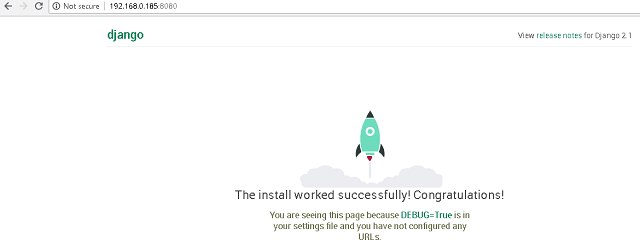
Let's start Django application named myblog and add to settings.py :
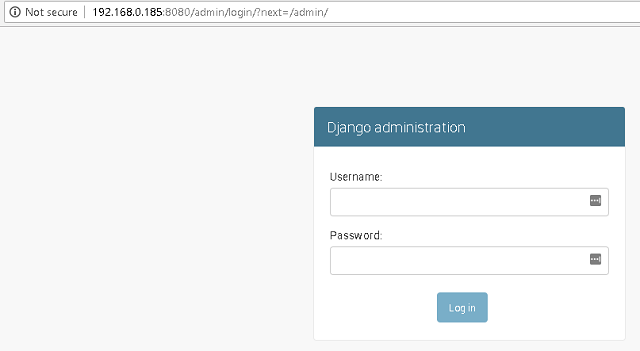
If you see some errors this will be fixed later.
Let's make a superuser with this command:
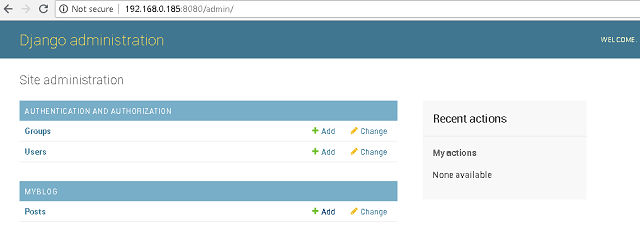
Click on the Add button from Posts to add your post.
The result is this:
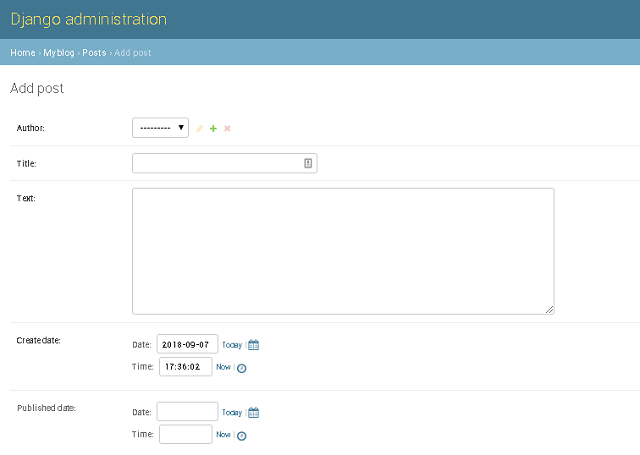
I don't make settings for URL and view.
This will be changed by users.
Add your python to the path environment variable under Windows O.S.
Create your working folder:
C:\Python364>mkdir mywebsiteC:\Python364>cd mywebsiteC:\Python364\mywebsite>python -m venv myvenv
C:\Python364\mywebsite>myvenv\Scripts\activate
(myvenv) C:\Python364\mywebsite>python -m pip install --upgrade pip
(myvenv) C:\Python364\mywebsite>pip3.6 install django
Collecting django
...(myvenv) C:\Python364\mywebsite>pip3.6 install django
Requirement already satisfied: django in c:\python364\mywebsite\myvenv\lib\
site-packages (2.1.1)
Requirement already satisfied: pytz in c:\python364\mywebsite\myvenv\lib\
site-packages (from django) (2018.5)(myvenv) C:\Python364\mywebsite>cd myvenv
(myvenv) C:\Python364\mywebsite\myvenv>cd Scripts
(myvenv) C:\Python364\mywebsite\myvenv\Scripts>django-admin.exe startproject mysite
(myvenv) C:\Python364\mywebsite\myvenv\Scripts>dir my*
(myvenv) C:\Python364\mywebsite\myvenv\Scripts>cd mysite
(myvenv) C:\Python364\mywebsite\myvenv\Scripts\mysite&(myvenv) C:\Python364\mywebsite\myvenv\Scripts\mysite>cd mysite
(myvenv) C:\Python364\mywebsite\myvenv\Scripts\mysite\mysite>notepad settings.pyTIME_ZONE = 'Europe/Paris'ALLOWED_HOSTS = ['192.168.0.185','mysite.com'](myvenv) C:\Python364\mywebsite\myvenv\Scripts\mysite\mysite>cd ..
(myvenv) C:\Python364\mywebsite\myvenv\Scripts\mysite>python manage.py migrate
Operations to perform:
Apply all migrations: admin, auth, contenttypes, sessions
Running migrations:
Applying contenttypes.0001_initial... OK
Applying auth.0001_initial... OK
Applying admin.0001_initial... OK
Applying admin.0002_logentry_remove_auto_add... OK
Applying admin.0003_logentry_add_action_flag_choices... OK
Applying contenttypes.0002_remove_content_type_name... OK
Applying auth.0002_alter_permission_name_max_length... OK
Applying auth.0003_alter_user_email_max_length... OK
Applying auth.0004_alter_user_username_opts... OK
Applying auth.0005_alter_user_last_login_null... OK
Applying auth.0006_require_contenttypes_0002... OK
Applying auth.0007_alter_validators_add_error_messages... OK
Applying auth.0008_alter_user_username_max_length... OK
Applying auth.0009_alter_user_last_name_max_length... OK
Applying sessions.0001_initial... OK(myvenv) C:\Python364\mywebsite\myvenv\Scripts\mysite>python manage.py runserver
192.168.0.185:8080
Performing system checks...
System check identified no issues (0 silenced).
September 07, 2018 - 16:30:13
Django version 2.1.1, using settings 'mysite.settings'
Starting development server at http://192.168.0.185:8080/
Quit the server with CTRL-BREAK.
[07/Sep/2018 16:30:16] "GET / HTTP/1.1" 200 16348
[07/Sep/2018 16:30:21] "GET / HTTP/1.1" 200 16348
Let's start Django application named myblog and add to settings.py :
(myvenv) C:\Python364\mywebsite\myvenv\Scripts\mysite>python manage.py startapp
myblog
(myvenv) C:\Python364\mywebsite\myvenv\Scripts\mysite>dir
(myvenv) C:\Python364\mywebsite\myvenv\Scripts\mysite>cd mysite
(myvenv) C:\Python364\mywebsite\myvenv\Scripts\mysite\mysite>notepad settings.py# Application definition
INSTALLED_APPS = [
'django.contrib.admin',
'django.contrib.auth',
'django.contrib.contenttypes',
'django.contrib.sessions',
'django.contrib.messages',
'django.contrib.staticfiles',
'myblog',
](myvenv) C:\Python364\mywebsite\myvenv\Scripts\mysite\mysite>cd ..
(myvenv) C:\Python364\mywebsite\myvenv\Scripts\mysite>cd myblog
(myvenv) C:\Python364\mywebsite\myvenv\Scripts\mysite\myblog>notepad models.pyfrom django.db import models
# Create your models here.
from django.utils import timezone
from django.contrib.auth.models import User
class Post(models.Model):
author = models.ForeignKey(User,on_delete=models.PROTECT)
title = models.CharField(max_length=200)
text = models.TextField()
create_date = models.DateTimeField(default=timezone.now)
published_date = models.DateTimeField(blank=True, null=True)
def publish(self):
self.publish_date = timezone.now()
self.save()
def __str__(self):
return self.title
(myvenv) C:\Python364\mywebsite\myvenv\Scripts\mysite\myblog>cd ..
(myvenv) C:\Python364\mywebsite\myvenv\Scripts\mysite>python manage.py
makemigrations myblog
Migrations for 'myblog':
myblog\migrations\0001_initial.py
- Create model Post
(myvenv) C:\Python364\mywebsite\myvenv\Scripts\mysite>python manage.py migrate
myblog
Operations to perform:
Apply all migrations: myblog
Running migrations:
Applying myblog.0001_initial... OK(myvenv) C:\Python364\mywebsite\myvenv\Scripts\mysite>cd myblog
(myvenv) C:\Python364\mywebsite\myvenv\Scripts\mysite\myblog>notepad admin.py(myvenv) C:\Python364\mywebsite\myvenv\Scripts\mysite\myblog>cd ..
(myvenv) C:\Python364\mywebsite\myvenv\Scripts\mysite>python manage.py runserver
192.168.0.185:8080
Performing system checks...
System check identified no issues (0 silenced).
September 07, 2018 - 17:19:00
Django version 2.1.1, using settings 'mysite.settings'
Starting development server at http://192.168.0.185:8080/
Quit the server with CTRL-BREAK.
If you see some errors this will be fixed later.
Let's make a superuser with this command:
(myvenv) C:\Python364\mywebsite\myvenv\Scripts\mysite>python manage.py
createsuperuser
Username (leave blank to use 'catafest'): catafest
Email address: catafest@yahoo.com
Password:
Password (again):
This password is too short. It must contain at least 8 characters.
Bypass password validation and create user anyway? [y/N]: y
Superuser created successfully.(myvenv) C:\Python364\mywebsite\myvenv\Scripts\mysite>python manage.py runserver
192.168.0.185:8080
Click on the Add button from Posts to add your post.
The result is this:

I don't make settings for URL and view.
This will be changed by users.
Wednesday, August 29, 2018
PyOpenGL: Fix Attempt to call an undefined function glutInit .
This tutorial is about how to fix this error using Python version 3.6.4 :
This is result of shader stereo depth image:
OpenGL.error.NullFunctionError: Attempt to call an undefined function glutInit,
check for bool(glutInit) before callingScripts>pip3.6.exe install PyOpenGL
Collecting PyOpenGL
Downloading https://files.pythonhosted.org/packages/9c/1d/4544708aaa89f26c97cc
09450bb333a23724a320923e74d73e028b3560f9/PyOpenGL-3.1.0.tar.gz (1.2MB)
100% |████████████████████████████████| 1.2MB 1.2MB/s
Building wheels for collected packages: PyOpenGL
Running setup.py bdist_wheel for PyOpenGL ... done
Stored in directory: C:\Users\catafest\AppData\Local\pip\Cache\wheels\6c\00\7f
\1dd736f380848720ad79a1a1de5272e0d3f79c15a42968fb58
Successfully built PyOpenGL
Installing collected packages: PyOpenGL
Successfully installed PyOpenGL-3.1.0c:\Python364\Scripts>cd ..
c:\Python364>python.exe opengl_001.py
Traceback (most recent call last):
File "opengl_001.py", line 182, in
StereoDepth().main()
File "opengl_001.py", line 173, in main
glutInit()
File "c:\Python364\lib\site-packages\OpenGL\GLUT\special.py", line 333, in glu
tInit
_base_glutInit( ctypes.byref(count), holder )
File "c:\Python364\lib\site-packages\OpenGL\platform\baseplatform.py", line 40
7, in __call__
self.__name__, self.__name__,
OpenGL.error.NullFunctionError: Attempt to call an undefined function glutInit,
check for bool(glutInit) before calling c:\Python364>cd Scripts
c:\Python364\Scripts>pip3.6.exe install PyOpenGL-3.1.2-cp36-cp36m-win_amd64.whl
Processing c:\python364\scripts\pyopengl-3.1.2-cp36-cp36m-win_amd64.whl
Installing collected packages: PyOpenGL
Found existing installation: PyOpenGL 3.1.0
Uninstalling PyOpenGL-3.1.0:
Successfully uninstalled PyOpenGL-3.1.0
Successfully installed PyOpenGL-3.1.2
c:\Python364\Scripts>pip3.6.exe install PyOpenGL_accelerate-3.1.2-cp36-cp36m-win
_amd64.whl
Processing c:\python364\scripts\pyopengl_accelerate-3.1.2-cp36-cp36m-win_amd64.w
hl
Installing collected packages: PyOpenGL-accelerate
Successfully installed PyOpenGL-accelerate-3.1.2This is result of shader stereo depth image:
Posted by
Cătălin George Feștilă
Labels:
2018,
error,
pyopengl,
PyOpenGL_accelerate,
python 3,
python modules,
tutorial,
tutorials
Sunday, July 15, 2018
Python 3.6.4 : Microsoft Azure - bad answer .
The Azure from Microsoft comes with the free account and $200 credit to explore services for 30 days.
I only have 7 days left from this free account.
During this time I tried to use it from scratch.
In this short tutorial, I will talk about this period,
First I used the python version 3.6.4 and the Azure development tools.
These are the links I follow:
I install the azure for python with :
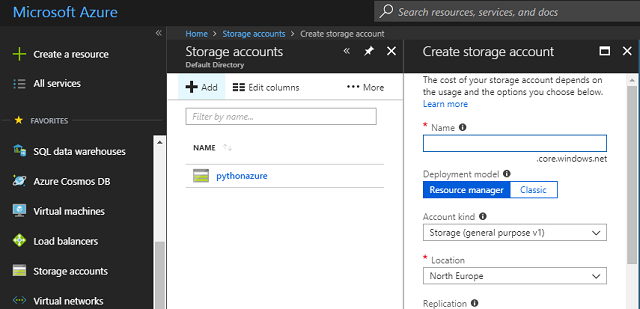
You can configure the Access control (IAM) to use with your account.
This storage account needs to use keys, see Access keys area.
They tell us about this feature:
Use access keys to authenticate your applications when making requests to this Azure storage account. Store your access keys securely - for example, using Azure Key Vault - and don't share them. We recommend regenerating your access keys regularly. You are provided two access keys so that you can maintain connections using one key while regenerating the other.
I change the account name with pythonazure and account_key with my account key.
The result is this:
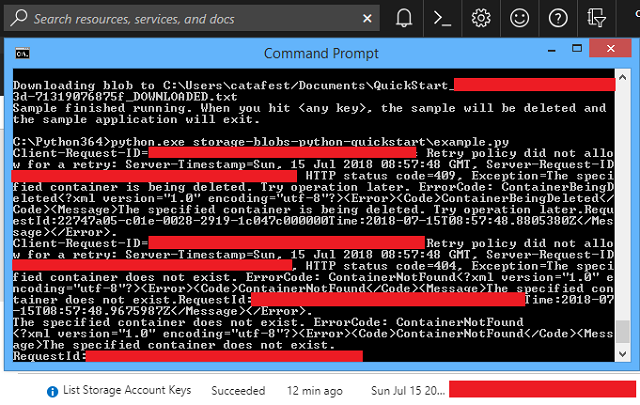
In view of my previous experiences with Google, Firebase and Azure on the ease of assimilation and understanding of the content and the time allocated to making a simple task according to the Azure documentation, then azure get the last place.
In azure services, we can see the errors that occur and which are non-existent on google or firebase.
I was interested in ease and fast access to python cloud services. However, you can read this point of view written by google here.
I only have 7 days left from this free account.
During this time I tried to use it from scratch.
In this short tutorial, I will talk about this period,
First I used the python version 3.6.4 and the Azure development tools.
These are the links I follow:
I install the azure for python with :
C:\Python364\Scripts>pip install azureC:\Python364\Scripts>pip install --pre azuregit clone https://github.com/Azure-Samples/storage-blobs-python-quickstart.git
You can configure the Access control (IAM) to use with your account.
This storage account needs to use keys, see Access keys area.
They tell us about this feature:
Use access keys to authenticate your applications when making requests to this Azure storage account. Store your access keys securely - for example, using Azure Key Vault - and don't share them. We recommend regenerating your access keys regularly. You are provided two access keys so that you can maintain connections using one key while regenerating the other.
I change the account name with pythonazure and account_key with my account key.
The result is this:

In view of my previous experiences with Google, Firebase and Azure on the ease of assimilation and understanding of the content and the time allocated to making a simple task according to the Azure documentation, then azure get the last place.
In azure services, we can see the errors that occur and which are non-existent on google or firebase.
I was interested in ease and fast access to python cloud services. However, you can read this point of view written by google here.
Posted by
Cătălin George Feștilă
Labels:
2018,
azure,
module,
python 3,
python modules,
tutorial,
tutorials
Tuesday, June 26, 2018
Python 3.6.4 : Trying to use the python azurure on the windows.
In this tutorial, I used the python version 3.6.4 and Windows 8.1 OS.
You can start with pip install tool for some azure modules:
Install the latest Batch runtime library
The next step is to open the Azure account - I have a trial free account.
I create a Resource Group named python-azure and a Storage account named pythonazure.
Into pythonazure I add the Files service and I upload an HTML file named default.html .
See the next images with the steps I make:
Let's make one simple test:
I found some inconsistencies and issues on GitHub so I still have to document.
Any help in this regard is welcome.
You can start with pip install tool for some azure modules:
Install the latest Batch runtime library
C:\Python364\Scripts>pip install azure-batch C:\Python364\Scripts>pip install azure-mgmt-scheduler C:\Python364\Scripts>pip install --pre azure-mgmt-compute C:\Python364\Scripts>pip install azure-storage --upgradeC:\Python364\Scripts>pip install --pre azure
...
Installing collected packages: azure-storage-nspkg, azure-storage-common, azure-
storage-queue, azure-servicebus, azure-servicefabric, azure-storage-file, azure-
servicemanagement-legacy, azure-mgmt-consumption, azure-mgmt-media, azure-mgmt-d
ns, azure-mgmt-search, azure-mgmt-cdn, azure-mgmt-compute, azure-mgmt-eventhub,
azure-mgmt-containerinstance, azure-mgmt-datalake-nspkg, azure-mgmt-datalake-ana
lytics, azure-mgmt-recoveryservices, azure-mgmt-authorization, azure-mgmt-adviso
r, azure-mgmt-recoveryservicesbackup, azure-mgmt-billing, azure-mgmt-devtestlabs
, azure-mgmt-network, azure-mgmt-web, azure-mgmt-applicationinsights, azure-mgmt
-cognitiveservices, azure-mgmt-rdbms, azure-mgmt-monitor, azure-mgmt-reservation
s, azure-mgmt-notificationhubs, azure-mgmt-loganalytics, azure-mgmt-logic, azure
-mgmt-iothubprovisioningservices, azure-mgmt-marketplaceordering, azure-mgmt-res
ource, azure-mgmt-scheduler, azure-mgmt-powerbiembedded, azure-mgmt-servicefabri
c, azure-mgmt-commerce, azure-mgmt-sql, azure-mgmt-cosmosdb, azure-mgmt-relay, a
zure-mgmt-storage, azure-mgmt-redis, azure-mgmt-managementpartner, azure-mgmt-tr
afficmanager, azure-mgmt-machinelearningcompute, azure-mgmt-datafactory, azure-m
gmt-hanaonazure, azure-mgmt-iothub, azure-mgmt-servermanager, azure-mgmt-batch,
azure-mgmt-keyvault, azure-mgmt-subscription, azure-mgmt-eventgrid, azure-mgmt-s
ervicebus, azure-mgmt-batchai, azure-mgmt-containerservice, azure-mgmt-container
registry, azure-mgmt-msi, azure-mgmt-datalake-store, azure-mgmt, azure-datalake-
store, azure-eventgrid, azure-keyvault, azure-cosmosdb-nspkg, futures, azure-cos
mosdb-table, azure-graphrbac, azure-storage-blob, azureThe next step is to open the Azure account - I have a trial free account.
I create a Resource Group named python-azure and a Storage account named pythonazure.
Into pythonazure I add the Files service and I upload an HTML file named default.html .
See the next images with the steps I make:
Let's make one simple test:
C:\Python364\Scripts>python
Python 3.6.4 (v3.6.4:d48eceb, Dec 19 2017, 06:54:40) [MSC v.1900 64 bit (AMD64)]
on win32
Type "help", "copyright", "credits" or "license" for more information.
>>> from azure.common.credentials import UserPassCredentials
>>> from azure.mgmt.resource import ResourceManagementClient
>>> from azure.mgmt.storage import StorageManagementClient
>>> from azure.storage import CloudStorageAccount
>>> from azure.storage.blob.models import ContentSettings, PublicAccess
>>> I found some inconsistencies and issues on GitHub so I still have to document.
Any help in this regard is welcome.
Posted by
Cătălin George Feștilă
Labels:
2018,
azure,
module,
modules,
online tool,
python 3,
python modules,
tool,
tutorial,
tutorials
Sunday, June 24, 2018
Python 3.6.4 : Using python client with blogger API .
I used a new project into console cloud google.
I used the google-api-python-client from here with OAuth service.
You need to create a project and add the blogger API to use it.
For credentials, I used OAuth with the JSON file from google.
This is the source code:
Run the python script:
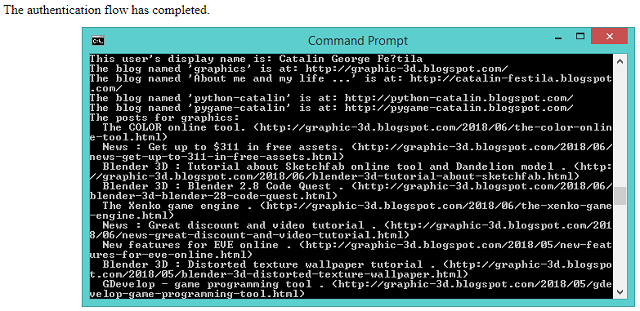
Google show us all the infos about this project into dashboard:
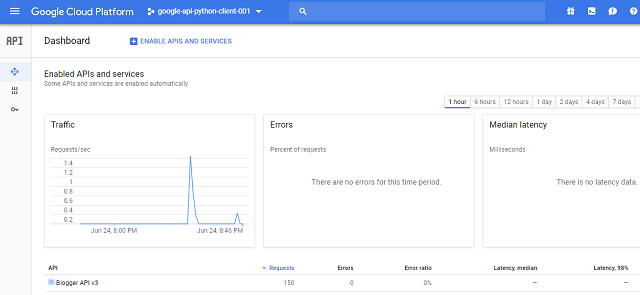
I used the google-api-python-client from here with OAuth service.
You need to create a project and add the blogger API to use it.
For credentials, I used OAuth with the JSON file from google.
This is the source code:
#!/usr/bin/env python
# -*- coding: utf-8 -*-
from __future__ import print_function
__author__ = 'Catalin George Festila ( catafest , mythcat )'
import sys
from oauth2client import client
from googleapiclient import sample_tools
def main(argv):
# Authenticate and construct service.
service, flags = sample_tools.init(
argv, 'blogger', 'v3', __doc__, __file__,
scope='https://www.googleapis.com/auth/blogger')
try:
users = service.users()
# Retrieve this user's profile information
thisuser = users.get(userId='self').execute()
print('This user\'s display name is: %s' % thisuser['displayName'])
blogs = service.blogs()
# Retrieve the list of Blogs this user has write privileges on
thisusersblogs = blogs.listByUser(userId='self').execute()
for blog in thisusersblogs['items']:
print('The blog named \'%s\' is at: %s' % (blog['name'], blog['url']))
posts = service.posts()
# List the posts for each blog this user has
for blog in thisusersblogs['items']:
print('The posts for %s:' % blog['name'])
request = posts.list(blogId=blog['id'])
while request != None:
posts_doc = request.execute()
if 'items' in posts_doc and not (posts_doc['items'] is None):
for post in posts_doc['items']:
print(' %s (%s)' % (post['title'], post['url']))
request = posts.list_next(request, posts_doc)
except client.AccessTokenRefreshError:
print ('The credentials have been revoked or expired, please re-run'
'the application to re-authorize')
if __name__ == '__main__':
main(sys.argv)
c:\Python364\google_api_python>dir
06/24/2018 08:27 PM 1,096 blogger.dat
06/24/2018 07:49 PM 2,599 blogger.py
06/24/2018 08:24 PM 309 client_secrets.json
06/24/2018 08:26 PM 76 debug.log
4 File(s) 4,080 bytes
2 Dir(s) 201,382,006,784 bytes free
Run the python script:
c:\Python364\google_api_python>python.exe blogger.py
Google show us all the infos about this project into dashboard:

Posted by
Cătălin George Feștilă
Labels:
2018,
google,
google-api-python-client,
module,
modules,
python 3,
python modules
Wednesday, June 6, 2018
Python 3.6.4 : The qrcode python module .
This python module named qrcode is a suite of tools to Generate QR codes.
Let's start the tutorial with the install steep :

Let's start the tutorial with the install steep :
c:\Python364\Scripts>pip install qrcode[pil]
Collecting qrcode[pil]
...
Successfully installed qrcode-6.0 >>> import qrcode
>>> from qrcode import *
>>> dir(qrcode)
['ERROR_CORRECT_H', 'ERROR_CORRECT_L', 'ERROR_CORRECT_M', 'ERROR_CORRECT_Q', 'LU
T', 'QRCode', '__builtins__', '__cached__', '__doc__', '__file__', '__loader__',
'__name__', '__package__', '__path__', '__spec__', 'base', 'constants', 'except
ions', 'image', 'main', 'make', 'run_example', 'util']
>>> dir(qrcode.util)
['ALPHA_NUM', 'BCH_digit', 'BCH_type_info', 'BCH_type_number', 'BIT_LIMIT_TABLE'
, 'BitBuffer', 'G15', 'G15_MASK', 'G18', 'LUT', 'MODE_8BIT_BYTE', 'MODE_ALPHA_NU
M', 'MODE_KANJI', 'MODE_NUMBER', 'MODE_SIZE_LARGE', 'MODE_SIZE_MEDIUM', 'MODE_SI
ZE_SMALL', 'NUMBER_LENGTH', 'PAD0', 'PAD1', 'PATTERN_POSITION_TABLE', 'QRData',
'RE_ALPHA_NUM', '__builtins__', '__cached__', '__doc__', '__file__', '__loader__
', '__name__', '__package__', '__spec__', '_data_count', '_lost_point_level1', '
_lost_point_level2', '_lost_point_level3', '_lost_point_level4', '_optimal_split
', 'base', 'create_bytes', 'create_data', 'exceptions', 'length_in_bits', 'lost_
point', 'mask_func', 'math', 'mode_sizes_for_version', 'optimal_data_chunks', 'o
ptimal_mode', 'pattern_position', 're', 'six', 'to_bytestring', 'xrange']
>>> dir(qrcode.image)
['__builtins__', '__cached__', '__doc__', '__file__', '__loader__', '__name__',
'__package__', '__path__', '__spec__', 'base']
>>> dir(qrcode.run_example)
['__annotations__', '__call__', '__class__', '__closure__', '__code__', '__defau
lts__', '__delattr__', '__dict__', '__dir__', '__doc__', '__eq__', '__format__',
'__ge__', '__get__', '__getattribute__', '__globals__', '__gt__', '__hash__', '
__init__', '__init_subclass__', '__kwdefaults__', '__le__', '__lt__', '__module_
_', '__name__', '__ne__', '__new__', '__qualname__', '__reduce__', '__reduce_ex_
_', '__repr__', '__setattr__', '__sizeof__', '__str__', '__subclasshook__']
>>> import qrcode
from qrcode import *
qr = qrcode.QRCode(
version=1,
error_correction=qrcode.constants.ERROR_CORRECT_L,
box_size=10,
border=4,
)
qr.add_data('https://python-catalin.blogspot.com/')
qr.make(fit=True)
img = qr.make_image(fill_color="black", back_color="white")
with open('my_qr_test.png', 'wb') as qrfile:
img.save(qrfile)
Posted by
Cătălin George Feștilă
Labels:
2018,
module,
modules,
python 3,
python modules,
qrcode,
tutorial,
tutorials
Saturday, May 26, 2018
Blender 3D and Roblox with Python .
I spend my free time with my son playing Roblox and in the meantime, I try to introduce him to the world of computers.
However, you can download the player as a 3D object and use it as an avatar.
Here's an issue: The 3D object is hard to set with origins for animation but python and Blender 3D can easily solve this.
You can use BMesh.
As you know:
BMesh is the new Blender mesh system in 2.63, with full support for N-sided polygons instead of only triangles and quads.
The result of this download 3D object has a bad origin:
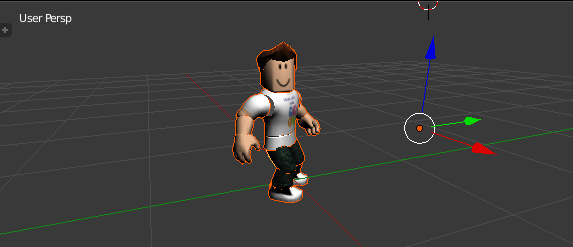
Let's see the source code:
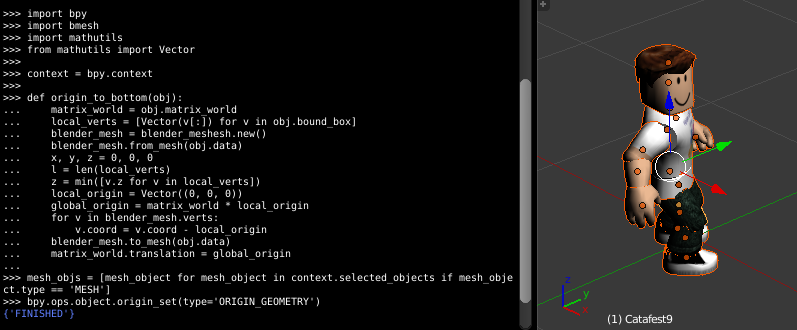
However, you can download the player as a 3D object and use it as an avatar.
Here's an issue: The 3D object is hard to set with origins for animation but python and Blender 3D can easily solve this.
You can use BMesh.
As you know:
BMesh is the new Blender mesh system in 2.63, with full support for N-sided polygons instead of only triangles and quads.
The result of this download 3D object has a bad origin:

Let's see the source code:
import bpy
import bmesh
import mathutils
from mathutils import Vector
context = bpy.context
def origin_to_bottom(obj):
matrix_world = obj.matrix_world
local_verts = [Vector(v[:]) for v in obj.bound_box]
blender_mesh = blender_meshesh.new()
blender_mesh.from_mesh(obj.data)
x, y, z = 0, 0, 0
l = len(local_verts)
z = min([v.z for v in local_verts])
local_origin = Vector((0, 0, 0))
global_origin = matrix_world * local_origin
for v in blender_mesh.verts:
v.coord = v.coord - local_origin
blender_mesh.to_mesh(obj.data)
matrix_world.translation = global_origin
mesh_objs = [mesh_object for mesh_object in context.selected_objects if mesh_object.type == 'MESH']
bpy.ops.object.origin_set(type='ORIGIN_GEOMETRY')
for my_objects in mesh_objs:
origin_to_bottom(my_objects)
Posted by
Cătălin George Feștilă
Labels:
2018,
3d,
Blender 3D,
python 3,
script,
tutorial,
tutorials
Subscribe to:
Comments (Atom)
